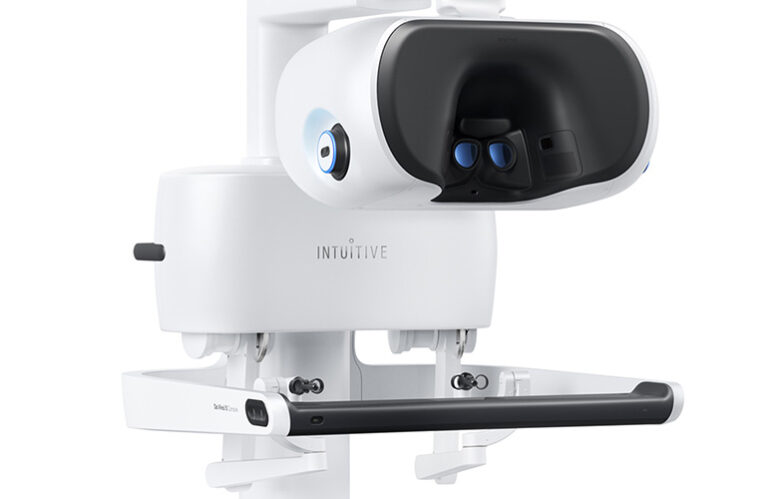Intuitive plans updates to the da Vinci 5 — including capabilities for surgeons using the console (pictured) — before fully launching the next generation of the surgical robot. | Source: Intuitive Surgical
Intuitive Surgical Inc. said it can’t make enough of its new da Vinci 5 robotic surgical system to meet customer demand.
But that’s part of the Synnyvale, Calif.-based company‘s plan for “measured rollout” so it can tweak the next-generation system based on feedback from early adopters like those that partnered with it on the da Vinci 5’s (DV5) development.
“Really strong start. … It looks like a strong launch,” said Larry Biegelsen, an analyst at Wells Fargo. He cited the 70 placements of DV5 in the second quarter.
There are three main items on Intuitive’s checklist ahead of a full-scale DV5 launch, said company executives on their second-quarter earnings call. They offered a blueprint for other device developers to take the same approach with their own product launches.
1. Expanding manufacturing capacity
With da Vinci 5 systems accounting for nearly half of Intuitive’s U.S. system placements in the past quarter, the surgical device manufacturer is ramping up production as part of the limited launch.
Chief Financial Officer Jamie Samath said DV5 placements will “increase modestly quarter to quarter” and “will be constrained through the first half of 2025.”
About half of the 550 employees Intuitive hired in the quarter were in manufacturing operations to help meet customer demand, he said.
“We are maturing our supply chain and our manufacturing capacity so that we’re able to get to the quality, to the cost, to the yields that we expect as we approach a broad launch,” stated Dave Rosa, president of Intuitive Surgical.
2. Updating hardware and software
Samath said Intuitive is planning a hardware and software update for da Vinci 5 in the second half of this year.
“You have to organize how you do that build plan through the factory carefully for that update,” he said.
Some of the first updates include the integration of Intuitive Hub capabilities, allowing surgeons to access and manipulate anatomical 3D models while they’re in the surgeon console. They also include access to intraoperative video for replay, Rosa said.
“We’re trying to get that integrated into our systems and balancing the factory output,” Rosa later added. He noted that more updates will come as a result of feedback from early DV5 users.
“Then if you look a little further out, some intraoperative technology building blocks that we’re working on such as procedure step mapping and 3D-depth mapping that will use some AI and [machine learning] algorithms and leverage this compute power of da Vinci 5,” Rosa said. “Those things will set us up to him for some more advanced features in the future.”
3. Gathering customer feedback
Other updates are coming as a result of requests and input from surgeons and healthcare organizations that are already using DV5, according to Intuitive Surgical executives.
“As these placements happen, we’re listening to our customers and responding to their feedback,” Rosa said. “We’ll be releasing some software updates along the way here in order to respond to that feedback, so we want to get that in place before we get to launch.”
Rosa said customer feedback is indicating improvements in precision, imaging, ergonomics, and integration. All of these could add up to improve overall efficiency and enable surgeons to perform one more procedure per day, he said.
“We launch new products thoughtfully, centered around outstanding customer experiences as our customers pursue operational and clinical excellence,” said Rosa. “We continue monitoring several key metrics across our measured rollout of da Vinci 5.”
Customer feedback is not only helping Intuitive polish the DV5’s performance and features before a full launch, but it’s also helping Intuitive determine how much demand there is from surgeons and healthcare systems.
“In the early phase of a launch, you have a tendency to see early adopters look for the latest technology, and also the larger institutions, the large IDNs [integrated delivery networks],” Samath said. “You have to give it some time to see the full set of customers in terms of what that interest will be.”
Customer feedback also provides data and anecdotes in support of the DV5 system to generate more demand and convert those who are DV5 curious into customers.
“Many customers will want to evaluate da Vinci 5; they’ll want to see evidence grow over time in terms of the capability and feature set,” Samath said. “And of course, their desire for da Vinci 5 will depend on their their individual program and what they see the value of that, in part given the higher pricing or lease costs for da Vinci 5.”
“As we move through our measured launch, we’ll continue to have to underscore and reinforce the value that it brings and communicate that to executives and their teams,” Rosa added.
The da Vinci 5 includes new features and equipment like a built-in insufflator. | Source: Intuitive Surgical
Intuitive expects da Vinci 5 to serve multiple goals
Intuitive expects DV5 to be evaluated not just by cost compared with other systems, but with the “quadruple” or “quintuple aim” of addressing clinician burnout and health equity, respectively, in mind, said CEO Gary Guthart.
“We’re confident that we’re going to get there. I think we’re going to develop the data to support that perspective,” he said. “The apples-to-apples price differences aren’t that great once you add the insufflator and some of the other things that are built in, and we’ve just got to justify that difference.”
“On first reflection and on case insights, these are powerful, foundational, new capabilities that are going into the market,” noted Guthart. “I think that’s really interesting, and we will work with leading customers to start evaluating where do they make sense and where don’t they.”
“We, of course, believe there are going to be procedures and patient populations where they make a ton of sense and they generate real value,” he said. “So early, it’s about data generation and research and feedback. And later, we’ll start to drive that through clinical publications and other things.”
“What you get today: You get precision, you get imaging, you get ergonomics, you get throughput, and there’s some things that in this platform, you get to participate in its research and development. And that will come later,” Guthart said. “And then it’s a core technology platform upon which we can build. … That set of sequences gives us some confidence to keep pushing hard.”
Editor’s note: This article was syndicated from The Robot Report sibling site Medical Design & Outsourcing.

 4 months ago
57
4 months ago
57













 English (US) ·
English (US) ·